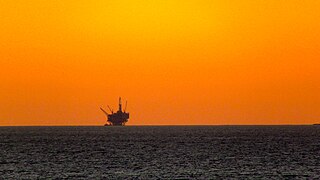
An oil platform, offshore platform, or offshore drilling rig is a large structure with facilities for well drilling to explore, extract, store, and process petroleum and natural gas that lies in rock formations beneath the seabed. Many oil platforms will also contain facilities to accommodate their workforce. Most commonly, oil platforms engage in activities on the continental shelf, though they can also be used in lakes, inshore waters, and inland seas. Depending on the circumstances, the platform may be fixed to the ocean floor, consist of an artificial island, or float. Remote subsea wells may also be connected to a platform by flow lines and by umbilical connections. These sub-sea solutions may consist of one or more subsea wells or of one or more manifold centres for multiple wells.
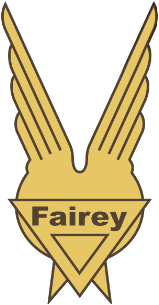
The Fairey Aviation Company Limited was a British aircraft manufacturer of the first half of the 20th century based in Hayes in Middlesex and Heaton Chapel and RAF Ringway in Cheshire. Notable for the design of a number of important military aircraft, including the Fairey III family, the Swordfish, Firefly, and Gannet, it had a strong presence in the supply of naval aircraft, and also built bombers for the RAF.

The Fairey Fulmar was a British carrier-borne reconnaissance aircraft/fighter aircraft developed and manufactured by aircraft company Fairey Aviation. It was named after the northern fulmar, a seabird native to the British Isles. The Fulmar served with the Royal Navy's Fleet Air Arm (FAA) during the Second World War.

HMS Argus was a British aircraft carrier that served in the Royal Navy from 1918 to 1944. She was converted from an ocean liner that was under construction when the First World War began and became the first example of the standard pattern of aircraft carrier, with a full-length flight deck that allowed wheeled aircraft to take off and land. After commissioning, the ship was involved for several years in the development of the optimum design for other aircraft carriers. Argus also evaluated various types of arresting gear, general procedures needed to operate a number of aircraft in concert and fleet tactics. The ship was too top-heavy as originally built and had to be modified to improve her stability in the mid-1920s. She spent one brief deployment on the China Station in the late 1920s before being placed in reserve for budgetary reasons.
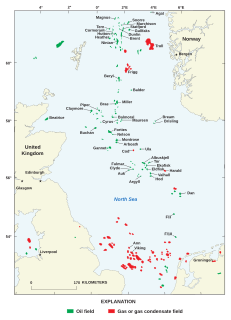
North Sea oil is a mixture of hydrocarbons, comprising liquid petroleum and natural gas, produced from petroleum reservoirs beneath the North Sea.
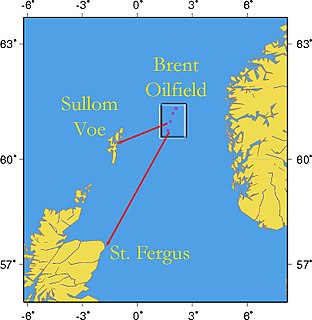
The Brent field is an oil and gas field located in the East Shetland Basin of the North Sea, 186 kilometres (116 mi) north-east of Lerwick, Shetland Islands, Scotland, at the water depth of 140 metres (460 ft). The field operated by Shell UK Limited was discovered in 1971 by semi-submersible drilling rig "Staflo" and was once one of the most productive parts of the UK's offshore assets but has reached the stage where production is no longer economically viable. Decommissioning of the Brent field is ongoing and will be completed in the early 2020s. The discovery well 211/26-1 was drilled in 1971 by the semi-submersible drilling rig "Staflo". This was a major surprise at the time as the nearest land in Scotland and Norway is composed of granite and other non reservoir metamorphic rocks.

The Auk Oilfield is situated 249 kilometres (155 mi) east, southeast of Aberdeen, Scotland, in block number 30/16. It was operated by Shell UK Exploration and Production Ltd, in 50% partnership with Esso until October 2006 when it was bought by Talisman Energy, and is now licensed by Repsol Sinopec Resources UK Ltd. It was discovered in October 1970 in a water depth of 182 metres. Estimated ultimate recovery is 88.5 million barrels of oil.

The Fulmar Oilfield is situated 312 km east of Dundee, Scotland, United Kingdom in block number 30/16 and 30/11b. It is operated by Repsol Sinopec who took over from the previous operator, Shell at the end of 2006. At this time Talisman also purchased the equity of the other partners ExxonMobil and Amerada Hess. The field was discovered in December 1975 by well 30/16-6 in a water depth of 82 metres. Estimated ultimate recovery is 544 million barrels of oil. It is named after the fulmar, a sea bird.

The St Fergus Gas Terminal is a large gas terminal found near St Fergus, Aberdeenshire, Scotland. The other main UK gas terminals are at Bacton, Norfolk and the Easington, East Riding of Yorkshire.
The Fulmar Gas Line is a natural gas pipeline which transports natural gas from the central North Sea to St Fergus, Scotland. Originally, the pipeline carried natural gas from Fulmar and Clyde fields. Later also other fields in the Central North Sea, such as Kittiwake, Gannet, Nelson, Anasuria, Curlew, and Triton were connected to the pipeline.
Norpipe is the undersea oil and natural gas pipelines system in the North Sea. It supplies oil from the Norwegian Ekofisk and associated fields in the North Sea to the United Kingdom and natural gas to Germany.

The Nairana-class escort carrier was a British-built class of three escort carriers. They were constructed one each in England, Scotland and Northern Ireland to the same basic design during the Second World War for service with the Royal Navy.
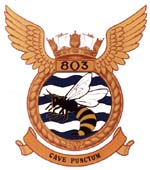
803 Naval Air Squadron was a Royal Navy Fleet Air Arm squadron.

807 Naval Air Squadron was a Naval Air Squadron of the Royal Navy.
Jupiter is a planet in the Solar System, named after Jupiter, the chief god in Roman mythology.
The Bulldog class was a four ship class of survey vessels in service with the Royal Navy from the late 1960s until the start of the 21st century. Initially designed with service overseas in mind, they spent most of their careers off the British coast. A fifth ship was subsequently built to a modified design to support them in their activities. Decommissioned and sold off at the end of the 20th and start of the 21st centuries, they have continued in service as civilian vessels, with some being converted to private yachts and others entering other commercial sectors.

The Irish Sea separates the islands of Ireland and Great Britain; linked to the Celtic Sea in the south by St George's Channel, and to the Inner Seas off the West Coast of Scotland in the north by the North Channel, also known as the Straits of Moyle.

Operation EF (1941), also the Raid on Kirkenes and Petsamo took place on 30 July 1941, during the Second World War. After the beginning of Operation Barbarossa, the German invasion of the Soviet Union on 22 June 1941, Fleet Air Arm aircraft flew from the aircraft carriers HMS Victorious and Furious to attack merchant vessels in the northern Norwegian port of Kirkenes and the north Finnish port of Liinakhamari in Petsamo.

The Elgin–Franklin fields are two adjacent gas condensate fields located in the Central Graben Area of the North Sea 240 kilometres (130 nmi) east of Aberdeen, Scotland at a water depth of 93 metres (305 ft). The joint development of the Elgin and Franklin fields is the largest high pressure high temperature development in the world, and also contains the world's hottest, highest temperature field, West Franklin, and the Glenelg field. On 25 March 2012, a gas leak occurred at the Elgin platform resulting in a shut down of production and evacuation of personnel. The leak continued for over seven weeks, and was stopped after well intervention work on 16 May 2012. Production from the fields restarted almost a year later, on 9 March 2013.
Gannet is an oil and gas field located in the United Kingdom’s continental shelf in the North Sea. It is 180 km (110 mi) east of Aberdeen, and the water depth at the Gannet offshore installation is 95 m (312 ft). The field is located in Blocks 22/21, 22/25, 22/26 and 21/30. It is half-owned by Royal Dutch Shell (50%) and partly by ExxonMobil (50%) and has been operated by Shell UK Ltd since ‘first oil’ in November 1993. The Gannet A installation is the host platform for subsea tiebacks designated Gannet B to G. Like most Shell fields in the central and northern North Sea the field is named after a sea bird the gannet.












